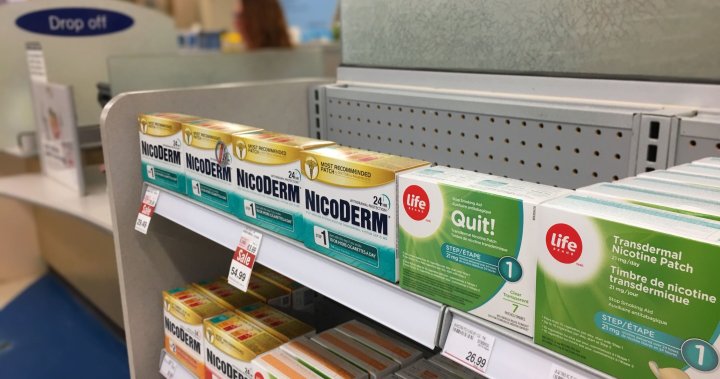Despite significant progress in understanding COVID-19, concrete treatments for people suffering with long-haul symptoms are still being studied. That’s why some may be resorting to unapproved remedies found on social media, such as one of the latest gaining attention: nicotine patches.
COVID long-haulers in the United States have taken to X, formerly known as Twitter, in the past few weeks to share their positive anecdotes with a guided use of slow-release nicotine patches to relieve symptoms.
The trend doesn’t appear to have caught on in Canada, but experts in the country are cautioning patients from trying it out until more research is done to support the medical use of nicotine.
“I understand the motivation, but I would really counsel people to really think long and hard before they commit to this going forward,” Dr. Brian Conway, medical director of the Vancouver Infectious Disease Centre, told Global News.
If you’re not already a regular consumer, Conway warned that nicotine can result in unwanted side effects such as nausea and headaches. Health Canada notes that new users may experience dizziness, weakness and stomach cramps as well.

Nicotine is found naturally in tobacco leaves and is what makes cigarettes so addictive. The substance can also be found in mints, gum and patches, which are intended to help people quit smoking. While the gum or lozenge can provide quick relief for cravings, patches provide a steady level of nicotine in the body to ease withdrawal symptoms, according to Health Canada.
Is there a scientific link between nicotine and COVID?
The current trend of nicotine patches and long COVID symptoms stems from a case study published in January 2023 by Dr. Marco Leitzke, which doesn’t state if it’s been peer-reviewed. It’s based on the theory that nicotine can displace the COVID-19 virus from the receptor, called ACE2, that the virus binds to, helping alleviate symptoms related to long COVID.
Get the latest Health IQ news.
Sent to your email, every week.
After wearing a nicotine patch for about a week, participants in the study noted an improvement in symptoms such as fatigue and weakness. Other symptoms such as loss of taste and smell began to alleviate around the two-week mark.
Conway says there is validity in the study’s hypothesis, but no more than many other theories that have trended on social media.
Part of the reason for his skepticism is that most studies that circulate are typically very small, including Leitzke’s, which only involved one female and three males.
“Just because you have a good idea and it makes sense, we generally do studies to make sure that that idea translates into measurable benefit. And we don’t have any of that data having to do with nicotine patches,” Conway said.
Despite the recent attention linking nicotine patches with long-COVID treatment, the idea isn’t new.
One study by researchers in France found early in the pandemic that there were more COVID outpatients who were smokers than non-smoking inpatients. Researchers hypothesized that smokers have some sort of protection against COVID that others don’t, but other studies and reviews later disproved the idea.
A study published last year in the Asthma, Allergy and clinical Immunology journal noted that nicotine and cigarette smoke have very different effects on the human body. Nicotine has both inflammatory and anti-inflammatory properties, the study says, which means it could have a worsening effect on some diseases such as diabetes, but play a healing role in the treatment of other diseases like multiple sclerosis.
The study concluded that nicotine has a “duel-effect” on the severity of COVID-19 recovery depending on dosage, but noted more research needs to be done before administering the substance as an official treatment.

The above mentioned studies don’t state whether they’ve been peer-reviewed.
Dr. Colin Furness, an infection control epidemiologist and assistant professor in the faculty of information at the University of Toronto, says it’s “entirely possible” that nicotine is effective in treating COVID long-haulers, but the data isn’t there just yet.
“We can go back to the idea that nicotine has anti-inflammatory properties… and some forms of long COVID seem to be very related to inflammation… but long COVID is also very complicated. I don’t want to be naïve about this. It’s not a question of slap on a patch and be immune,” Furness told Global News.
“The problem is that medical science takes a long time to get anywhere. So in five years, 10 years, 15 years, we might have some great treatments for long COVID. But that’s obviously very little comfort to people who are suffering now,” he said.
Lack of treatments leading to misinformation, experts say
Currently, there is no cure for long COVID and treatments are scarce. Symptoms can range from extreme fatigue, difficulty breathing, chest pain, dizziness, depression or anxiety or stomach pain, according to Health Canada.
In Canada, Paxlovid (a mix of two anti-viral drugs, oral nirmatrelvir and ritonavir) is the most commonly used treatment option to help ease COVID-19 symptoms. It is currently authorized for use during acute illness — and there is a Canadian clinical trial underway for the long-term use of Paxlovid that may help COVID long-haulers — but again, there still isn’t a magic pill.
While the exact number of long COVID cases remains uncertain in Canada, preliminary findings from Health Canada’s March 2023 report on the disease found more than 17 per cent of adults who got the virus reported longer-term symptoms after having had COVID-19.
That same month, The Lancet estimated that approximately 65 million people are living with long COVID worldwide. Without answers, many of those sufferers seek advice on social media.
“It’s not surprising that people are seeking alternative treatments, and it’s not surprising that those are available. Some of them may be effective. The pathway to establish whether that’s the case or not is a really long one, and that’s an unfortunate limitation of medicine and science,” Furness said.

Without a clear definition and diagnostic criteria of long COVID, misinformation is able to spread, he says.
“This confusion and lack of precision, the variety of manifestations of long COVID, it’s a real challenge. We’ve got a real mismatch between the way COVID behaves and the way we like to think. It makes denial easier. It means that alternative treatments are going to crop up,” Furness said.
Dr. Zahid Butt, an infectious disease epidemiologist at the University of Waterloo, says social media plays a “pivotal role” in pandemic communications and the spread of misinformation.
Butt says the best way patients can assure the information they’re receiving is accurate is to do their research and visit reliable websites such as Health Canada, the U.S. Centers for Disease Control (CDC), the Public Health Agency of Canada and the World Health Organization (WHO).
“Because a lot of these social media websites have a lot of misinformation, some of it intentional and some unintentional, (patients should) verify the information, especially if it’s related to a health topic,” Butt told Global News.
Family doctors are another good source for validating information if you’re fortunate enough to have one, Butt says, but engage with the health care system any way you can.
“It’s possible that there will be new drugs developed for long COVID, so I think there is light at the end of the tunnel,” he said.




